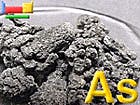To ensure drinking water technologies are available for consumers to reduce exposure to arsenic, the not-for-profit NSF International just released four final verification reports through the EPA/NSF Environmental Technology Verification (ETV) Drinking Water Systems (DWS) Center. These new reports were produced to specify testing results of drinking water treatment technologies that help consumers avoid exposure to arsenic, which can increase cancer risk and cause other serious health problems.
These reports are an important step in protecting the public from arsenic exposure," said Bruce Bartley, NSF’s technical manager in the ETV DWS Center. "By providing consumers with proven results of product evaluations, these evaluation reports accelerate the implementation of new drinking water technologies into the marketplace."
The ETV DWS Center reports demonstrate a significant reduction of arsenic in drinking water. These tests were performed in small communities in three states in conjunction with Delta Industrial Services and the University of Alaska at Anchorage in Anchorage, Alaska; Watts Premier and MWH in Thermal, California; Kinetico, Inc. and Alcan Chemicals with Gannett Fleming in Carroll Township, Pennsylvania; and ADI International with Gannett Fleming in Sellersville, Pennsylvania.
In 2001, the U.S. Environmental Protection Agency (EPA) issued a new arsenic maximum contaminant level (MCL) of 10 micrograms per liter (µg/L). Since that time, public health officials throughout the United States have detected varying amounts of arsenic in many drinking water supplies, some well above EPA's new MCL.
As of January 23, 2006, all public water systems will be required to comply with the 10 µg/L MCL.
With assistance through an EPA grant, NSF International entered into an agreement on October 1, 2000 with the EPA to form the ETV DWS Center. The ETV DWS Center is dedicated to providing independent performance evaluations of drinking water technologies and helping small communities comply with the 10 µg/L MCL.
The reports can be accessed at the following web pages:
Delta Industrial Services, Anchorage, Alaska Full Report: http://www.nsf.org/business/drinking_water_systems_center/pdf/Delta_Report.pdf
Watts Premier, Thermal, California Full Report:
http://www.nsf.org/business/drinking_water_systems_center/pdf/Watts_Report.pdf
Kinetico, Inc. and Alcan Chemicals, Carroll Township, Pennsylvania Full Report: http://www.nsf.org/business/drinking_water_systems_center/pdf/Kinetico-Alcan_ETV_Report.pdf
ADI International, Sellersville, Pennsylvania Full Report:
http://www.nsf.org/business/drinking_water_systems_center/pdf/ADI_Phase1_Report.pdf
"NSF expects the release of three additional reports on arsenic reduction technologies for drinking water in 2005," concluded Bartley. For additional information on these final reports, please contact Bruce Bartley at 1-800-NSF-MARK ext. 5148, (734) 769-5148, or [email protected].
Source: NSF


